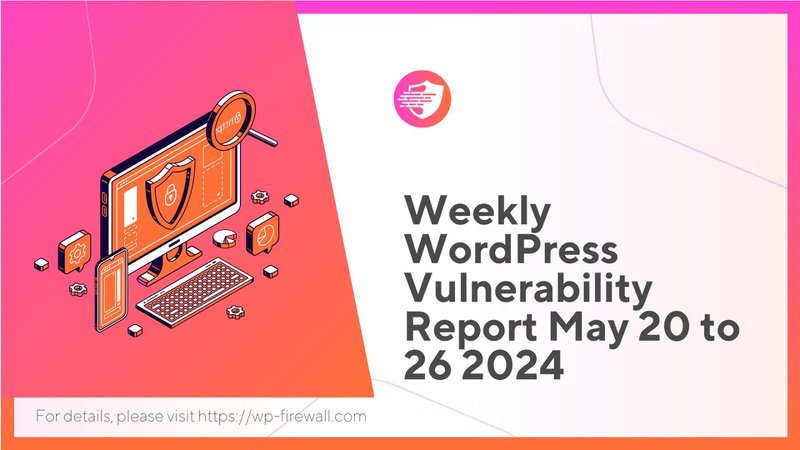
Relatório quinzenal de vulnerabilidades do WordPress: 20 de maio de 2024 a 26 de maio de 2024
Introdução
Bem-vindo ao nosso abrangente relatório quinzenal de vulnerabilidades do WordPress. Este relatório tem como objetivo manter os administradores de sites do WordPress informados sobre as últimas ameaças de segurança, ajudando a proteger seus sites de ataques em potencial. Abrangendo o período de 20 de maio de 2024 a 26 de maio de 2024, este relatório fornece uma visão geral das vulnerabilidades recém-descobertas, seus impactos e as melhores práticas para mitigar essas ameaças. No cenário em constante evolução da segurança cibernética, manter-se atualizado sobre as vulnerabilidades é crucial para manter a segurança do site e proteger os dados do usuário.
Resumo das principais vulnerabilidades
Durante este período de relatório, um total de 134 vulnerabilidades foram identificadas em 110 plugins do WordPress e um tema. Entre essas vulnerabilidades, 99 foram corrigidas, enquanto 35 permanecem sem correção. As vulnerabilidades variam em gravidade, com 108 classificadas como gravidade média, 19 como gravidade alta e 7 como críticas.
Vulnerabilidades críticas
1. Plugin de diretório de negócios – Diretórios de listagem fácil para WordPress (<= 6.4.2)
– Tipo: Injeção de SQL não autenticada
– Classificação CVSS: 9.8
– Status: Remendado
2. País Estado Cidade Menu suspenso CF7 (<= 2.7.2)
– Tipo: Injeção de SQL não autenticada
– Classificação CVSS: 9.8
– Status: Remendado
3. Hash Form – Construtor de formulários de arrastar e soltar (<= 1.1.0)
– Tipo: Upload de arquivo arbitrário não autenticado para execução remota de código
– Classificação CVSS: 9.8
– Status: Remendado
4. Pie Register – Login em sites sociais (Add on) (<= 1.7.7)
– Tipo: Ignorar autenticação
– Classificação CVSS: 9.8
– Status: Remendado
5. UserPro – Comunidade e Perfil de Usuário WordPress Plugin (<= 5.1.8)
– Tipo: Apropriação de conta não autenticada para escalonamento de privilégios
– Classificação CVSS: 9.8
– Status: Remendado
6. Diretório Web Gratuito (<= 1.6.9)
– Tipo: Injeção de SQL não autenticada
– Classificação CVSS: 9.8
– Status: Remendado
7. Complementos WPZOOM para Elementor (Modelos, Widgets) (<= 1.1.37)
– Tipo: Inclusão de arquivo local não autenticado
– Classificação CVSS: 9.8
– Status: Remendado
Análise detalhada de vulnerabilidades
1. Vulnerabilidades de injeção de SQL:
Vulnerabilidades de injeção de SQL estão entre as mais críticas, pois permitem que invasores executem consultas SQL arbitrárias no banco de dados. Isso pode levar a acesso não autorizado a dados confidenciais, manipulação de banco de dados e até mesmo tomada de controle total do site. As vulnerabilidades de injeção de SQL encontradas em plugins como Business Directory, Country State City Dropdown CF7 e Web Directory Free podem permitir que invasores explorem fraquezas do banco de dados sem precisar autenticar.
2. Vulnerabilidades de upload de arquivos arbitrários:
A vulnerabilidade no Hash Form – Drag & Drop Form Builder permite que invasores carreguem arquivos arbitrários, que podem então ser executados no servidor. Esse tipo de vulnerabilidade pode ser particularmente prejudicial, pois pode levar à execução remota de código, permitindo que invasores assumam o controle total do site.
3. Vulnerabilidades de desvio de autenticação:
Vulnerabilidades como as encontradas no Pie Register – Social Sites Login podem permitir que invasores ignorem mecanismos de autenticação, concedendo a eles acesso não autorizado a contas de usuários. Em alguns casos, isso também pode levar à escalada de privilégios, onde os invasores ganham acesso administrativo.
4. Vulnerabilidades de inclusão de arquivo local:
A vulnerabilidade do plugin WPZOOM Addons for Elementor permite que invasores incluam arquivos locais no servidor. Isso pode ser explorado para ler arquivos sensíveis, como arquivos de configuração contendo credenciais de banco de dados, ou para executar scripts maliciosos.
Impacto das Vulnerabilidades
As vulnerabilidades descobertas representam riscos significativos para sites WordPress, incluindo:
– Violações de dados: Os invasores podem acessar informações confidenciais armazenadas no banco de dados, levando a possíveis violações de dados e comprometendo a privacidade do usuário.
– Desfiguração do site: Vulnerabilidades de upload de arquivos arbitrários e execução de código podem ser usadas para alterar o conteúdo do site, desfigurar o site ou injetar conteúdo malicioso.
– Infecções por malware: Explorar essas vulnerabilidades pode resultar na implantação de malware, que pode se espalhar para visitantes e outras partes do site, levando a problemas de segurança mais amplos.
– Interrupções de serviço: Ataques bem-sucedidos podem causar tempo de inatividade, interrompendo serviços e afetando negativamente a experiência e a confiança do usuário.
Mitigação e Recomendações
Para proteger seu site WordPress dessas vulnerabilidades, é essencial seguir estas práticas recomendadas:
1. Atualizar regularmente:
– Garanta que todos os plugins e temas estejam atualizados para suas versões mais recentes. Os desenvolvedores frequentemente lançam patches para corrigir vulnerabilidades conhecidas, então manter seu site atualizado é crucial.
2. Implement Medidas de segurança fortes:
– Use senhas fortes e exclusivas para todas as contas de usuário e habilite a autenticação de dois fatores (2FA) para uma camada adicional de segurança.
– Instale um plugin de segurança confiável, como o Wordfence, para monitorar e proteger seu site de várias ameaças.
3. Backups regulares:
– Faça backups regulares do seu site para garantir que você possa restaurá-lo rapidamente em caso de ataque ou perda de dados. Armazene os backups em um local seguro e externo.
4. Monitorar atividade do site:
– Revise regularmente os logs e relatórios de atividade do seu site para identificar qualquer comportamento incomum ou potenciais ameaças de segurança. Configure alertas para atividades suspeitas.
5. Limitar acesso:
– Restrinja o acesso à sua área de administração do WordPress a endereços IP confiáveis e limite as funções dos usuários às permissões mínimas necessárias.
Apresentando o WP-Firewall
O WP-Firewall oferece uma solução abrangente para proteger seu site WordPress de vulnerabilidades e ameaças. O plano gratuito inclui recursos essenciais de segurança, como:
– Detecção de ameaças em tempo real: Monitora e bloqueia atividades maliciosas conforme elas acontecem, garantindo que seu site permaneça protegido 24 horas por dia.
– Proteção de Firewall: Impede acesso não autorizado e defende contra ataques comuns baseados na web, como injeção de SQL e script entre sites (XSS).
– Verificação de malware: Verifica regularmente seu site em busca de malware, identificando e removendo códigos maliciosos antes que eles possam causar danos.
– Atualizações automáticas: Mantém seus plugins e temas atualizados automaticamente, garantindo que você sempre tenha os patches de segurança mais recentes.
Benefícios do WP-Firewall
Usar o WP-Firewall oferece inúmeras vantagens, incluindo:
1. Segurança aprimorada:
– O WP-Firewall oferece proteção avançada contra uma ampla gama de ameaças, ajudando a manter seu site seguro contra vulnerabilidades conhecidas e emergentes.
2. Desempenho aprimorado:
– Ao bloquear tráfego malicioso e reduzir a carga no seu servidor, o WP-Firewall pode ajudar a melhorar o desempenho e a estabilidade do seu site.
3. Paz de espírito:
– Com o WP-Firewall protegendo ativamente seu site, você pode se concentrar na criação de conteúdo e na administração do seu negócio, sabendo que seu site é seguro.
4. Esforço de manutenção reduzido:
– Atualizações automáticas e verificações regulares significam menos tempo gasto no gerenciamento de segurança e mais tempo para outras tarefas importantes.
Estudos de caso: WP-Firewall em ação
1. Estudo de caso 1:
– Um site de e-commerce WordPress era frequentemente alvo de ataques de injeção de SQL, levando a violações de dados e reclamações de clientes. Após implementar o WP-Firewall, o site experimentou uma redução significativa nos ataques e nenhuma outra violação de dados.
2. Estudo de caso 2:
– Um blog popular enfrentou repetidas desfigurações devido a vulnerabilidades de upload de arquivos. A detecção de ameaças em tempo real e a varredura de malware do WP-Firewall ajudaram a evitar mais incidentes e restauraram a integridade do site.
O que você ainda está esperando? Melhore o nível de segurança do seu site WordPress agora mesmo!
Proteja seu site WordPress hoje mesmo assinando o plano gratuito WP-Firewall. Medidas de segurança proativas são cruciais para manter a integridade e a segurança do seu site. Não espere até que seja tarde demais—inscreva-se no plano gratuito do WP-Firewalle garanta que seu site permaneça seguro contra as ameaças mais recentes.
Conclusão
Neste relatório, destacamos as principais vulnerabilidades descobertas de 20 de maio de 2024 a 26 de maio de 2024, seus impactos potenciais e as etapas necessárias para mitigá-las. Manter-se informado sobre vulnerabilidades e tomar medidas proativas para proteger seu site WordPress é essencial. O WP-Firewall oferece proteção abrangente para ajudar você a proteger seu site e ter paz de espírito. Inscreva-se hoje e faça da segurança uma prioridade para seu site WordPress.

